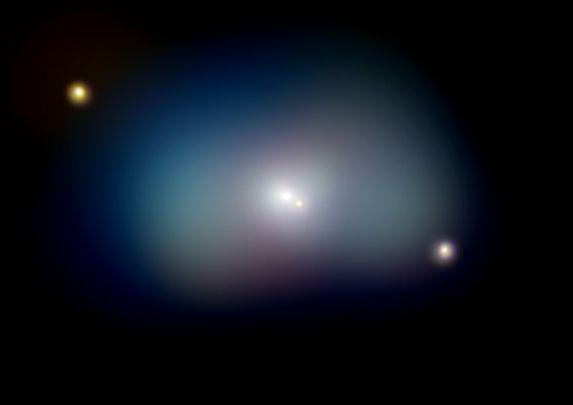Explanation: In spiral galaxies, majestic winding arms of young stars and interstellar gas and dust rotate in a disk around a bulging galactic nucleus. Elliptical galaxies seem to be simpler, randomly swarming with old stars and lacking gas and dust. So astronomers were excited to find that NGC 1700, a young elliptical galaxy about 160 million light-years away, shows evidence for a 90,000 light-year wide rotating disk of multi-million degree hot gas. The evidence comes from data recorded by the orbiting Chandra Observatory, whose sharp x-ray image of NGC 1700 is seen above. Balancing gravity, the rotation of the x-ray hot disk, the largest of its type yet discovered, gives the galaxy a pronounced boxy profile in this false-color picture. Theories about the origin of the disk suggest that NGC 1700 may be the result of a cosmic scale galactic merger, perhaps between a spiral and elliptical galaxy. NGC 1700 is just visible with small telescopes toward the flowing constellation Eridanus.
1998 1999 2000 2001 2002 2003 2004 2005 2006 2007 2008 2009 2010 2011 2012 2013 2014 2015 2016 2017 2018 2019 2020 2021 2022 2023 2024 |
Январь Февраль Март Апрель Май Июнь Июль Август Сентябрь Октябрь Ноябрь Декабрь |
NASA Web Site Statements, Warnings, and Disclaimers
NASA Official: Jay Norris. Specific rights apply.
A service of: LHEA at NASA / GSFC
& Michigan Tech. U.
|
Публикации с ключевыми словами:
NGC 1700 - Elliptical Galaxy - merging galaxies - эллиптическая галактика - рентгеновские наблюдения - сталкивающиеся галактики
Публикации со словами: NGC 1700 - Elliptical Galaxy - merging galaxies - эллиптическая галактика - рентгеновские наблюдения - сталкивающиеся галактики | |
См. также:
Все публикации на ту же тему >> | |
